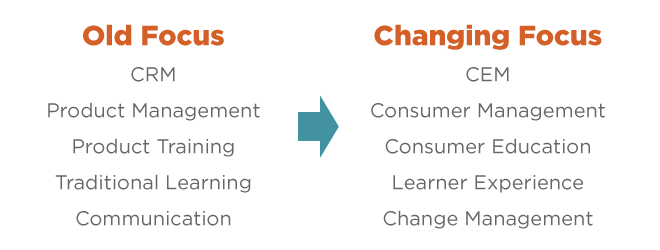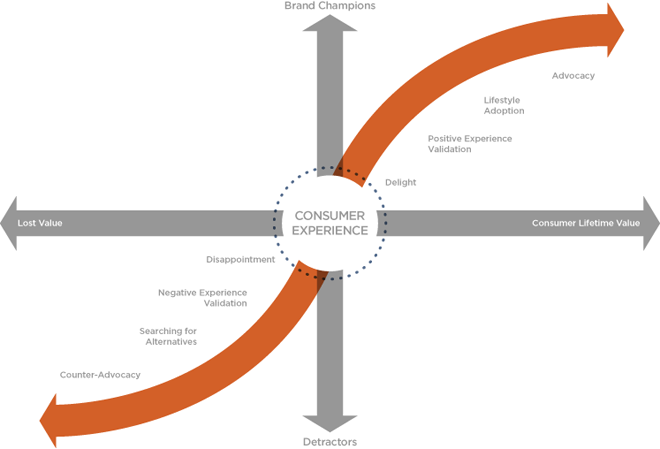As consumer relationship management (CRM) technologies have matured, it isn’t surprising that some competing/complementary systems have also gained traction. One among many such responses, CEM, focuses on consumer experience (or engagement depending on what you’re reading). The argument is that CRM is too IT-focused (how do we track, record, classify, rank, and tag the consumer?) whereas the correction of CEM promises to help us better understand and foster that which is foundational to consumer loyalty, a consumer’s actual experience. NPS, or Net Promoter Score—Satmetrix’s trademark metric—aims to become the standard indicator for CEM and several retail organizations are either launching NPS programs in their organizations or using data from NPS measurement to reorient learning and development.
This shift matters because it is part of a Changing Brand Landscape with implications that go beyond the normal evolution of industry buzzwords. Let’s run quickly through a highly abbreviated series of related, overlapping shifts. Doing so will highlight the critical role that learning and consumer education can play in engaging consumers and in optimizing the consumer experience.

From CRM to CEM:
As noted above, this focus moves the emphasis from an enabling technology (CRM) to what should be the terminal, end objective (CEM). In our retail practice, we see this shift as a critical refocus where the same metrics that drive the business become the primary focus of management and associate training. One of our clients uses NPS metrics as a feedback and scoring system to underscore the value of the metric, teach the terminology, and align individual efforts with company objectives.
From Product Management to Consumer Management:
In a much-cited article in the Harvard Business Review, Roland T. Rust, Christine Moorman, and Gaurav Bhalla reposition product management as more consumer-centric, consumer management. While the shift in focus may seem overly obvious, the rationale aligns with changes in relationship marketing, loyalty marketing, and (specifically to my field of work) in product training.
From Product Training to Consumer Education:
Product training has long been considered tangential to (or a subset of) a larger product marketing strategy. It becomes much more integral when consumer education becomes the focus. One of our clients sells a healthcare product that will become much more widely available through the Affordable Care Act. Product management would dictate topics on use, maintenance, and product features. A consumer-management strategy doesn’t ignore these topics but incorporates them in solutions on lifestyle, childcare, wellness, etc. The training isn’t separate from the social media strategy or the content marketing strategy—it’s central to it.
From Traditional Learning to Learner Experience:
What marketing has traditionally thought of as learning or training has changed dramatically over the last 10 years. With new technologies and approaches for social, mobile, video, etc., the options are more flexible and more easily integrated with other marketing strategies. For example, one of our clients has produced a series of YouTube videos that combine elements of safety training with public service messages, disaster response information, and practical how-to videos for home improvement projects.
From Communication to Change Management:
Often, when we speak of communication and change management, we’re talking about internal corporate initiatives and not consumer management. It isn’t surprising, however, that the change-management curve parallels the NPS model. It suggests how to take brand detractors and passives and make them champions. Below, I’ve taken our change management model and replaced the language to show some of the similarities between change management and CEM. (Click on each image to enlarge)
If we can support the consumer experience through the initial experience of delight–to validate the positive experience and to adopt the product or service “lifestyle”–that consumer becomes an advocate and brand champion. If we persist in defining training in the conventional sense, we don’t have many tools for supporting the consumer experience. By reconceptualizing it, the options are varied, flexible, and more easily targeted. Imagine a consumer experience portal that allows you to bring together your consumer education and content marketing strategies. We did just this for a client in the health insurance industry—the resulting portal shares health lifestyle stories around various products and services. It’s much more than a product guide—they are creating a collective narrative about wellness in the community.
Our challenge as leaders in performance is to highlight the relevancy of what we can do and what we can do, specifically, in supporting, delighting, and sustaining consumers, building them up as brand champions and guiding them in their advocacy. What projects are you working on that strengthen the consumer experience? Share your stories below or learn more at http://bit.ly/brandscape.





